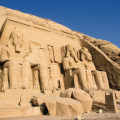TEMPLE OF RAMSES II
Go there and contact
The great temple of Abu Simbel was the brainchild of Ramses II. It took almost 20 years to build it out of the rock, and from it emerged this major architectural masterpiece of antiquity. It is dedicated to Amun-Ra, the most powerful god of the Theban cult, to Ra-Harakhty, who dominates the Heliopolitan cult, to Ptah, the center of the Memphis cult, and to Ramses II, the deified god.
The politico-religious significance of this temple is monumental, as if Pharaoh wanted to bring together here the three Egyptian cults, each of which had its hour of glory. He himself, by divinizing himself, as is his right since he is the successor to Ra, who was succeeded by Shu, then Gheb, then Osiris, then Horus, then Pharaoh, whose cycle continues up to him, son of Seti I, of the 19th dynasty, victorious in so many victories over his enemies, and builder of so many temples dedicated to the cult of his successor, Ra.
The temple's façade is preceded by 4 monumental statues of Ramses II seated, accompanied by his beloved wife, Nefertari, his mother, Mouttouy, and his sons and daughters. They reach heights of over 20 m. In the niche surmounting the temple entrance, the falcon-headed Ra-Harakhty stands erect, surmounted by the solar globe. A frieze of baboons completes the upper part of the façade.
A short corridor leads into the first hypostyle hall, supported by eight Osirid statues in the guise of Ramses II. On the left, they wear the white crown of Upper Egypt, on the right the double crown of the united country. The walls magnify royal victories, particularly that of Qadesh over the Hittites.
This leads into a second hypostyle hall with 4 square pillars, where Pharaoh presents offerings to the major deities of the Egyptian pantheon. A vestibule follows this hall into the sanctuary, where four seated statues stand impassively awaiting today's visitor, the priest of Amun in Pharaoh's time. These are the three major gods of the three cults and that of Ramses II.
Various chambers cut into the rock expand the ten-room temple, decorated with bas-reliefs in different colors. The axis of the temple doorway to the sanctuary was designed so that the sun would strike the statues on October 22 and February 22 of each year to celebrate festivities dear to Ramses II.
You can also visit the modern structure that backs onto the temple, which was cut up and assembled here when it was moved prior to the construction of the Aswan Dam. The contrast is interesting.
Did you know? This review was written by our professional authors.
Members' reviews on TEMPLE OF RAMSES II
The ratings and reviews below reflect the subjective opinions of members and not the opinion of The Little Witty.
After a tour bus you arrive in front of lake nasser which quickly gives way to the most beautiful wonder of the world...










En ce mois de novembre 2016, j'étais absolument seul sur le site : pas une âme, il était bien sûr 10h30 du matin et environ 300 personnes avaient déjà fait la visite.
Le voyage en venant d'Assouan est long mais vous devez le faire. Le temps des départs en convoi à 4h00 du matin n'est plus d'actualité et vous pouvez donc choisir le moyen de transport.